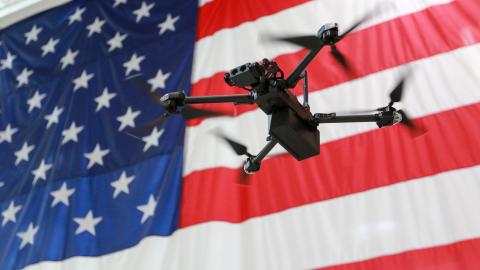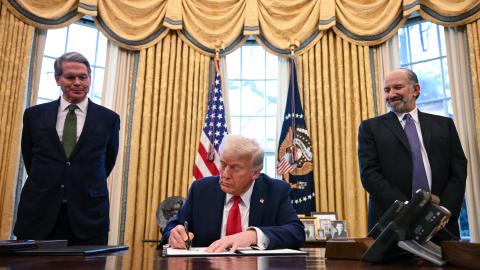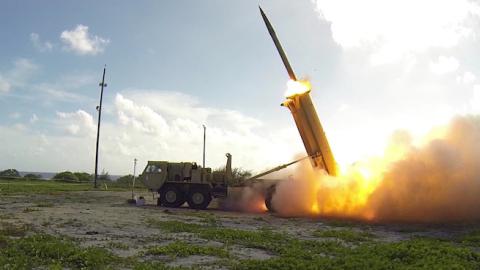North Korea may be preparing its sixth nuclear test since 2006 and conducting three missile launches since President Trump’s inauguration. Iran has also increased the tempo of its missiles tests, Russia is more brazenly violating an anti-missile treaty and threatening the use of missiles against U.S. allies, and China is investing in cutting edge missile technologies to hold at risk U.S. assets on land, at sea, and in space.
While each country has unique diplomatic complexities requiring a different combination of soft and hard power responses, the global proliferation of missiles combined with their affordability and lethality demands the United States have the most effective means to counter them.
Seeming to appreciate the threat sufficiently, Mr. Trump has made improving the layered U.S. missile defense system an expressed priority since he was on the campaign trail. The dead-of-the-night deployment of the Terminal High Altitude Area Defense (THAAD) battery to South Korea is a good down payment on that commitment, but just the beginning of adequately addressing the threat.
The most important takeaway from the THAAD deployment is that the United States moved forward with it despite intense Chinese objections. The Obama administration could have deployed THAAD but was intimidated by Chinese objections and reluctant to lean forward with the initiative when the South Korean government grew uncertain in the face of Chinese threats. However, South Korea’s uncertainty could also be understood to have grown worse because of U.S. waffling. One certainly gets the sense the South Koreans are much more confident the United States will not tolerate aggression against them with President Trump and Secretary of Defense Mattis at the helm.
One constructive criticism about the way Secretary Mattis handled the situation would be that he seemed to concede the argument that it would be out of bounds for the United States to deploy THAAD if it had been technically capable of defending against Chinese missiles. He did this when in South Korea in February he said, “Were it not for the provocative behavior of North Korea, we would have no need for THAAD out here…There is no other nation that needs to be concerned about THAAD.”
While technically true, the message is off. The right message is that the United States will deploy defenses against perceived threats from wherever they originate. The alternative is to intentionally remain vulnerable to some countries, like China, which weakens the hand of the United States, limits U.S. freedom of movement and action, and ultimately empowers countries working against the United States. “Mutual vulnerability” or any of its iterations, whether explicitly or implicitly stated, is Cold War thinking that no longer applies to the modern threat dynamic. Even if THAAD cannot put a dent in the Chinese missile arsenal, the United States should reserve the right to deploy another system that can, and shouldn’t hedge or apologize for it.
At the end of April, there will be a security dialogue between the United States and Japan. Media reports indicate the Japanese are looking forward to discussing plans to expand missile defense cooperation in response to North Korea’s repeated missile tests. The two countries already have a successful partnership with the co-development of the Aegis SM-3 IIA program, and successfully intercepted a medium-range ballistic missile target in a test this year. President Trump and Japanese President Abe have stated their commitment to cooperatively deal with an increasingly provocative North Korea and strengthening missile defense between the two countries and South Korea should be part of the larger set of military and diplomatic responses.
Beyond expanding regional missile defense in Asia, the United States must simultaneously follow through with its missile defense commitments in Europe and build on them in response to Russia’s threats and violations of the Intermediate-Range Nuclear Forces (INF) treaty. The United States is scheduled to deploy Aegis Ashore to Poland by 2018. This must remain on schedule, and the United States must also work with allies to deploy defenses against Russian cruise missiles. Moreover, just like the THAAD deployment to South Korea despite Chinese objections, expanding missile defense in Europe that defends U.S. troops and allies should move forward despite Russian objections.
Most importantly, the United States must methodologically expand its missile defense capabilities and invest in new technologies to protect Americans here at home. The backbone of the current missile defense system that provides homeland defense is the Ground-based Midcourse Defense (GMD) system, with missile fields in Alaska and California.
The plan is to have 44 interceptors on the ground by the end of FY2017. But the United States is already playing catch-up. North Korea demonstrated in February that it could orbit a satellite, technology directly applicable to an intercontinental ballistic missile (ICBM). Public intelligence reports have also indicated that even though the North Koreans have not successfully launched an ICBM, that through modeling, the U.S can assume that should North Korea decide to deliver a nuclear missile to the U.S., it could do it, if unreliable. Even if it does not have this capability now, with each test, it shows it is overcoming technological hurdles and remains committed to achieving the ability to coerce the United States with a nuclear capability. It is but a matter of time.
The Obama administration cut the GMD program in half, and the program has predictably had a mixed test record. GMD will greatly benefit from predictable funding levels that include investments to sustain and improve it. Expanding the number of interceptors to 106, thus increasing the number of defensive “bullets in the chamber,” would provide redundancy and extend the umbrella of coverage to the Eastern shores of the U.S. This could also significantly improve the reliability of GMD against North Korean and Iranian ballistic missile threats in the near term.
However, even if the U.S. takes full advantage of these current capabilities, it still needs to invest in technologies that will significantly increase the quality of the defensive system. Meaning the deployment of a satellite constellation that enables the U.S. to observe missiles from launch preparations through intercept, known as birth-to-death tracking. Currently, the U.S. relies on sea and land based sensors that lack complete coverage.
Last, the U.S. must also move forward with steps to deploy an initial space-based interceptor capability, which it could build on over time. Space is the optimal location to host interceptors capable of intercepting the most sophisticated offensive missiles in the boost phase of flight before the missile has the chance to release decoys and countermeasures.
If the Trump administration does move forward with this ambitious missile defense agenda, critics will claim it is too costly. It is challenging to assess the exact cost without knowing factors like the burden allies would share and the decrease in cost per item when more items are purchased at once. A back-of-the-envelope calculation shows it could be achieved by simply adding roughly $4 billion to the Missile Defense Agency annual budget, bringing the total to approximately $12 billion. Less than 2% of the defense budget. For some perspective, Americans spend roughly $18 billion on video games annually.
Providing for the common defense is one of the few explicitly Constitutionally-mandated responsibilities of the federal government and a more robust, layered missile defense system. A multilayered missile defense system would also serve as a deterrent to current and potential adversaries, and should deterrence fail; the U.S. would be protected. A cost-effective means to ensure the safety of all Americans.

















